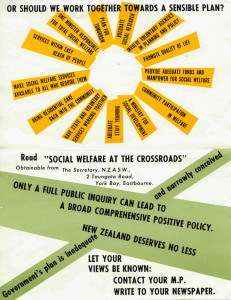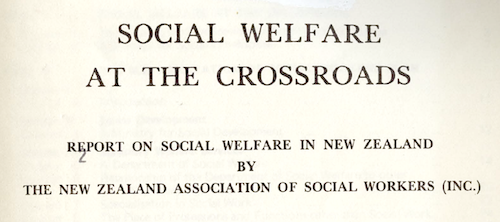In 1971 Keith Holyoake – the Prime Minister of the second National government – was still in power, there were anti-Vietnam War protests in Queen Street, and (in the USA) Charles Manson was found guilty of the murder of Sharon Tate and four others.
At this time the fledgling New Zealand Association of Social Workers (NZASW) was engaged in a campaign to influence government proposals to merge the Department’s of Child Welfare and Social Security into an integrated Department of Social Welfare. Mary Nash (1998) describes the two different schools of thought that existed inside the association at the time: the idealists and the pragmatists.
The idealists were opposed to the amalgamation of Child Welfare and Social Security, considered that it was proposed for political, economic and administrative reasons which did not consider client interests. They did, however, approve of the idea of a Department of Social Welfare that would unify the provision of statutory social services in a one door policy along the lines recommended in the Seebohm Report for England and Wales. They were opposed to the administrative combination of social service with income maintenance.
The pragmatists, while not disagreeing with these points, believed that changes were inevitable and that it was preferable to co-operate and have some input into developments that would protect the rights of the client. They recommended, therefore, that the Association make a case for time to be taken over the necessary deliberations that should precede the implementation of the amalgamation. They wanted the Association to ask that a White Paper on the Government’s amalgamation proposal be published before legislation and that the Royal Commission on Social Security should also report before further action was taken. (Nash, 1998, p. 198).

In the end the association decided to hire the services of a public relations consultant and to mount “A serious and expensive campaign…in order that the principles which inform social work should be taken into account in the amalgamation process” (Nash, 1998, p. 199). One output of this campaign was the publication Social Welfare at the Crossroads (NZASW, 1971), “a blueprint which not only argued against the amalgamation of the Child Welfare Division and the Income Support Service, but also put forward a comprehensive alternative which paid meticulous attention to the practicalities of implementation and which called for increased resources for the education and training of social workers”. (Nash, 1998, p. 199)

Holyoake refused the request for a full public enquiry, or a Royal Commission into the social services, and insisted that the new Department of Social Welfare would have responsibility for training statutory and voluntary social workers.
the Association replied with a forceful letter urging him to take more time to give the country the opportunity for debate on the matter. The Wellington branch reacted with a resolution which expressed their ” ‘amazement and deep concern’ at the ‘indecent haste’ with which the Government was rushing this legislation through. They went on “We believe that the Government’s purported aim of achieving complete amalgamation by 1 April 1972 points clearly to their lack of interest or regard for what the public and social workers think about social welfare”. (Nash, 1998, p. 199)
You can download a copy of the Social Welfare at the Crossroads report, and one of the campaign posters, by clicking the images above or the links below.
References
New Zealand Association of Social Workers (1971). Social Welfare at the Crossroads: Report on Social Welfare in New Zealand. NZASW: Wellington, New Zealand.
Nash, M. (1998). People, policies and practice: Social work education in Aotearoa/New Zealand from 1949 – 1995. PhD Thesis. Massey University, New Zealand, Palmerston North, New Zealand.

I think this was initiated by Margery Heads who called a seminar to air these ideas. It was hand printed, I think, at Mahina Bay by Charles Bagnall. We got the typesetting done commercially and it came as a block of linotype.